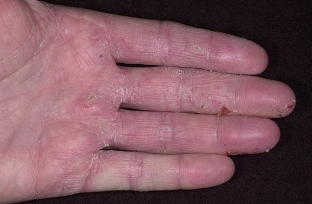Allergic dermatitis is a delayed the body's response to an external stimulus. At the same time, the irritant does not cause allergies in other people, but in a particular person, increased sensitivity, or sensitization, to this substance is formed for a long time due to frequent direct contact with the skin. At first, it is not visible, and the first manifestation can be moderately unpleasant, but subsequent manifestations of allergic dermatitis are violent – with edema, blisters on the skin, inflammation. Diagnosing allergic dermatitis is not difficult, but the doctor should question the patient in detail and examine him carefully.
Why and who develops allergic dermatitis
Most often, various chemicals and their compounds become allergens for the human body. These can be:
- components of medicines, perfumes and cosmetics,
- chromium or nickel compounds in jewelry and clasps,
- Ingredients for detergents and hair dyes.
Often, allergic dermatitis is an individual reaction of the human body to a specific irritant that does not disturb other healthy people at all. Usually it is about one specific chemical element or a group of similar elements that, when in contact with the skin, cause skin sensitization.
Immune cells, lymphocytes, are sent to the site of contact with the skin of the irritant, and their accumulations in the focus of contact with the chemical is immediately visible when examined under a microscope. Tiny allergen molecules are not recognized by lymphocytes, but when released into the bloodstream, the allergen binds to large protein molecules and becomes an excellent target for immune cells.
An important role in the development of allergic dermatitis is played by phagocytes of the skin, capable of destroying any protein molecules together with allergen particles and immune complexes. If an allergen gets on the skin of a person sensitive to it, then the number of phagocytes in this place for a few hours increases exponentially. It is phagocytes that contribute to the appearance of a developed immune response & nbsp; in the patient's body, when, upon repeated contact with the allergen, a stream of antibodies rushes to the place of this contact, and the doctor deals with a particularly violent manifestation of allergic dermatitis: a protective reaction of the skin is manifested by edema, hyperemia, itching, vasodilation, and the appearance of blisters.

Signs of allergic dermatitis and principles of treatment
The symptoms of allergic dermatitis in many ways resemble the acute stage of eczema. Large red spots form on the skin, which are covered with small bubbles. Then the bubbles burst, forming weeping surfaces, and then crusts and small scales appear on these surfaces.
Usually, allergic dermatitis is manifested by several foci: one – main, in the place of direct contact with allergen, others – on any part of the body, even very far from the main focus. For example, allergic dermatitis caused by mascara will cause swelling and redness of the eyelids, as well as red itchy and weeping spots on the neck, shoulders and even on the stomach.
The main complaint that a patient with allergic dermatitis makes is a very strong constant itching, which unbearably torments day and night. Therefore, the principles of treatment are based, first of all, on the selection of desensitizing therapy, which will alleviate the suffering of the patient. Antipruritic agents are prescribed for both general and local action. The patient is recommended a hypoallergenic diet, and after determining the allergen, an individual treatment regimen is selected.
It should be noted that allergic dermatitis is practically not treatable with folk remedies due to the specifics of the formation of the body's immune response, and the patient should definitely be notified about this so that the treatment prescribed by the doctor is effective.







Add a comment